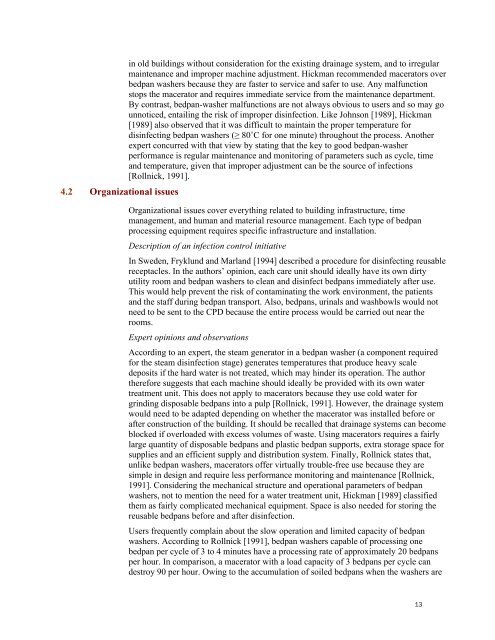Comparative Analysis of Bedpan Processing Equipment - Hygie
Comparative Analysis of Bedpan Processing Equipment - Hygie
Comparative Analysis of Bedpan Processing Equipment - Hygie
Create successful ePaper yourself
Turn your PDF publications into a flip-book with our unique Google optimized e-Paper software.
4.2 Organizational issues<br />
in old buildings without consideration for the existing drainage system, and to irregular<br />
maintenance and improper machine adjustment. Hickman recommended macerators over<br />
bedpan washers because they are faster to service and safer to use. Any malfunction<br />
stops the macerator and requires immediate service from the maintenance department.<br />
By contrast, bedpan-washer malfunctions are not always obvious to users and so may go<br />
unnoticed, entailing the risk <strong>of</strong> improper disinfection. Like Johnson [1989], Hickman<br />
[1989] also observed that it was difficult to maintain the proper temperature for<br />
disinfecting bedpan washers (≥ 80˚C for one minute) throughout the process. Another<br />
expert concurred with that view by stating that the key to good bedpan-washer<br />
performance is regular maintenance and monitoring <strong>of</strong> parameters such as cycle, time<br />
and temperature, given that improper adjustment can be the source <strong>of</strong> infections<br />
[Rollnick, 1991].<br />
Organizational issues cover everything related to building infrastructure, time<br />
management, and human and material resource management. Each type <strong>of</strong> bedpan<br />
processing equipment requires specific infrastructure and installation.<br />
Description <strong>of</strong> an infection control initiative<br />
In Sweden, Fryklund and Marland [1994] described a procedure for disinfecting reusable<br />
receptacles. In the authors’ opinion, each care unit should ideally have its own dirty<br />
utility room and bedpan washers to clean and disinfect bedpans immediately after use.<br />
This would help prevent the risk <strong>of</strong> contaminating the work environment, the patients<br />
and the staff during bedpan transport. Also, bedpans, urinals and washbowls would not<br />
need to be sent to the CPD because the entire process would be carried out near the<br />
rooms.<br />
Expert opinions and observations<br />
According to an expert, the steam generator in a bedpan washer (a component required<br />
for the steam disinfection stage) generates temperatures that produce heavy scale<br />
deposits if the hard water is not treated, which may hinder its operation. The author<br />
therefore suggests that each machine should ideally be provided with its own water<br />
treatment unit. This does not apply to macerators because they use cold water for<br />
grinding disposable bedpans into a pulp [Rollnick, 1991]. However, the drainage system<br />
would need to be adapted depending on whether the macerator was installed before or<br />
after construction <strong>of</strong> the building. It should be recalled that drainage systems can become<br />
blocked if overloaded with excess volumes <strong>of</strong> waste. Using macerators requires a fairly<br />
large quantity <strong>of</strong> disposable bedpans and plastic bedpan supports, extra storage space for<br />
supplies and an efficient supply and distribution system. Finally, Rollnick states that,<br />
unlike bedpan washers, macerators <strong>of</strong>fer virtually trouble-free use because they are<br />
simple in design and require less performance monitoring and maintenance [Rollnick,<br />
1991]. Considering the mechanical structure and operational parameters <strong>of</strong> bedpan<br />
washers, not to mention the need for a water treatment unit, Hickman [1989] classified<br />
them as fairly complicated mechanical equipment. Space is also needed for storing the<br />
reusable bedpans before and after disinfection.<br />
Users frequently complain about the slow operation and limited capacity <strong>of</strong> bedpan<br />
washers. According to Rollnick [1991], bedpan washers capable <strong>of</strong> processing one<br />
bedpan per cycle <strong>of</strong> 3 to 4 minutes have a processing rate <strong>of</strong> approximately 20 bedpans<br />
per hour. In comparison, a macerator with a load capacity <strong>of</strong> 3 bedpans per cycle can<br />
destroy 90 per hour. Owing to the accumulation <strong>of</strong> soiled bedpans when the washers are<br />
13


